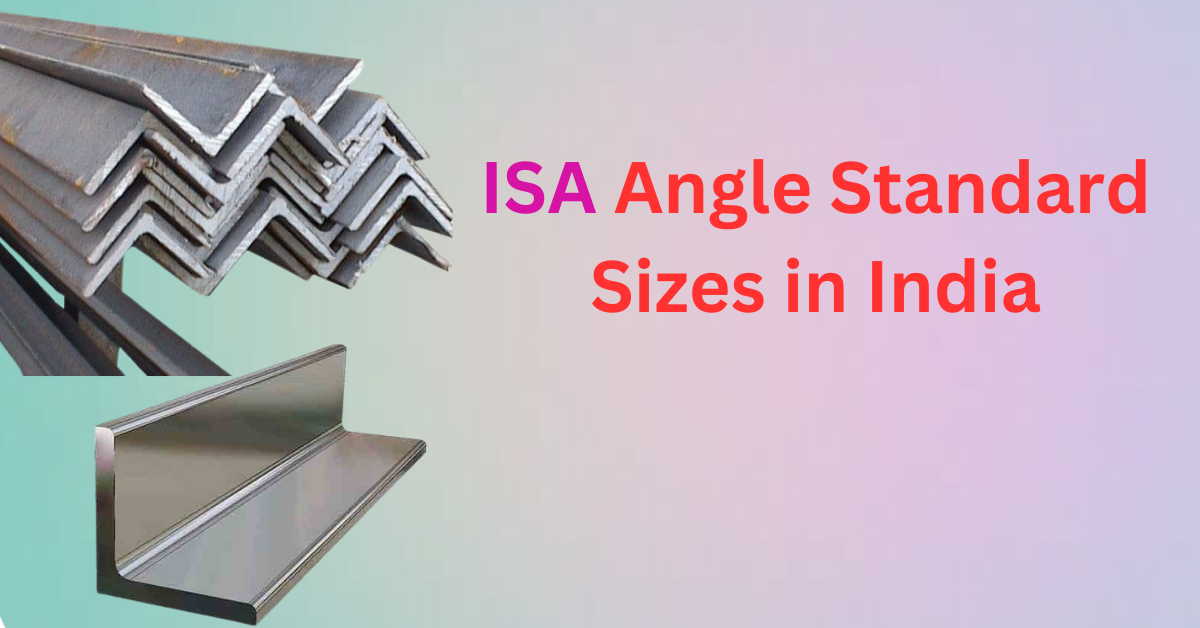ISA Angle Sizes in India: Comprehensive Details and Guide
Introduction
Indian Standard Angles (ISA) are one of the most commonly used structural elements in the construction and engineering industries in India. These angles are widely utilized in various projects ranging from buildings, bridges, and towers to industrial and infrastructure applications. The ISA angles are characterized by their “L”-shaped cross-section, which provides strength and stability to structures. This article provides an in-depth exploration of ISA angle sizes available in India, their specifications, applications, and methods for calculating their weight.
1. Standard Sizes of ISA Angles
ISA angles are standardized by the Bureau of Indian Standards (BIS), and the specifications are provided under IS 808: 1989 (reaffirmed 1999) “Dimensions for Hot Rolled Steel Beam, Column, Channel, and Angle Sections.” The standard sizes of ISA angles are denoted by the lengths of their legs and their thickness. These sizes typically range from smaller angles used in lightweight structures to larger ones employed in heavy-duty constructions.
Common Sizes of ISA Angles
Here are some of the commonly available ISA angle sizes in India:
- ISA 25x25x3 mm
- ISA 30x30x3 mm
- ISA 40x40x5 mm
- ISA 50x50x5 mm
- ISA 65x65x6 mm
- ISA 75x75x6 mm
- ISA 90x90x6 mm
- ISA 100x100x8 mm
- ISA 125x125x10 mm
- ISA 150x150x12 mm
- ISA 200x200x15 mm
- ISA 250x250x25 mm
The first two numbers represent the length of the two legs of the angle in millimeters (mm), and the third number indicates the thickness of the angle.
read more-
- H-Beam Standard Sizes in India
- How to fit a flange to pipe any degree
- HOW TO FIND ANGLE OF TRIANGLE LENGTH
2. Classification of ISA Angles
ISA angles are classified into two categories based on the lengths of their legs:
Equal Angles
Equal angles have both legs of the same length. For example, an ISA 50x50x5 mm angle has two legs each measuring 50 mm in length.
Unequal Angles
Unequal angles have legs of different lengths. For instance, an ISA 90x60x6 mm angle has one leg measuring 90 mm and the other 60 mm.
3. Applications of ISA Angles
ISA angles are versatile and find usage in a variety of applications across different sectors. Below are some common applications:
Construction Industry
- Structural Frameworks: Used as primary structural elements in buildings, bridges, and towers.
- Reinforcement: provides additional strength to concrete structures.
Industrial Applications
- Machinery and Equipment: Used in the fabrication of machinery, cranes, and heavy equipment.
- Support Structures: employed in supporting pipelines, conveyors, and storage racks.
Infrastructure Development
- Railways: utilized in the construction of railway bridges and platforms.
- Power Plants: Used in the fabrication of towers and other structures in power generation facilities.
4. Weight Calculation of ISA Angles
The weight of an ISA angle is an important factor for structural engineers and designers. The weight is typically calculated per meter length and can be derived using a standard formula.
Weight Calculation Formula
The formula for calculating the weight of an ISA angle per meter length is:
Where:
- Length of leg 1 and length of leg 2 are in millimeters (mm).
- Thickness is in millimeters (mm).
- 0.00785 is the density of steel in kg/mm3.
Example Calculation
Let’s calculate the weight of an ISA 50x50x5 mm angle.
So, the weight of the ISA 50x50x5 mm angle is approximately 3.73 kg/m.
5. Advantages of Using ISA Angles
ISA angles offer several advantages, making them a preferred choice in various applications:
- High Strength-to-Weight Ratio: Provides significant strength without adding much weight to the structure.
- Versatility: Can be used in numerous structural configurations.
- Durability: Offers long-lasting performance under various environmental conditions.
- Ease of Fabrication: Can be easily cut, drilled, and welded to suit different structural needs.
6. Standards and Quality Compliance
ISA angles produced in India must comply with the standards set by the Bureau of Indian Standards (BIS). The IS 808:1989 standard specifies the dimensions, tolerances, and properties of hot-rolled steel angles. Compliance ensures that the angles meet the necessary strength, durability, and safety requirements for construction and industrial use.
7. Selection Criteria for ISA Angles
When selecting ISA angles for a specific application, consider the following factors:
- Load Requirements: Determine the load the angle needs to support and choose an angle with appropriate strength and thickness.
- Environmental Conditions: Consider factors such as humidity, temperature, and exposure to chemicals, which may affect the material’s durability.
- Fabrication Needs: Ensure the angle can be easily fabricated and integrated into the overall structure.
- Cost: Balance the material cost with the required performance to ensure cost-effectiveness.
8. Conclusion
ISA angles are indispensable components in the construction and industrial sectors due to their versatility, strength, and ease of use. Understanding the various sizes, classifications, and weight calculations of ISA angles is crucial for engineers, architects, and builders to make informed decisions in their projects. By adhering to the standards set by the BIS and considering the specific requirements of each application, ISA angles can significantly contribute to the strength and stability of various structures.
In summary, ISA angles, with their wide range of sizes and specifications, offer a reliable and efficient solution for numerous structural applications in India. Their extensive use in construction, industrial, and infrastructure projects underscores their importance in modern engineering and architecture.
